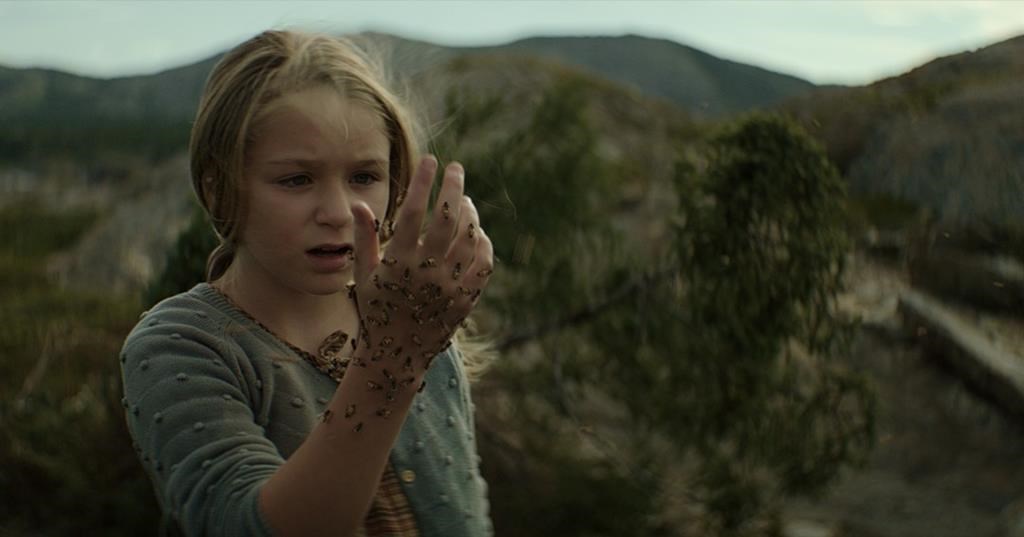Reviews
‘Satan’s Slaves: Communion’ Review – Joko Anwar Goes Bigger and More Macabre With Shudder Sequel

Indonesian horror master Joko Anwar’s Satan’s Slaves, a loose remake of the 1980 horror movie, became the highest-grossing domestic Indonesian film of 2017 and continued to terrify audiences across the globe. Between its success, reputation for scares, and an ending that set up a larger mythos, it’s no surprise that Anwar would follow up with a sequel a few years later. Satan’s Slaves: Communion relocates its setting to a high-rise apartment complex and plunges its residents into more expansive horror and storytelling.
Three years after the unsettling events of the first film, the surviving Suwono family members now live in a rundown Jakarta apartment building. Rini (Tara Basro) works at a factory and grapples with whether to go off to college to improve their financial situation or stay and remain a surrogate mom to brothers Toni (Endy Arfian), and Bondi (Nasar Anuz) as dad Bahri (Bront Palarae) sneaks off all the time. Just as they finally move on from their ordeal and feel safe from the Satanic terror induced by mom’s passing, a catastrophic storm moves in, trapping them in place as a new wave of Hell unleashes.

Satan’s Slaves: Communion – Photo Credit: Shudder
Bahri’s choice to move his children to a higher populated location is sound in theory; their isolated family home in the countryside left them vulnerable and almost entirely alone in their fight against supernatural forces. It also provides writer/director Anwar with a much higher body count and a sprawling slaying ground. Save for a 1955-set intro to set up the background mythology, Communion settles into establishing the building, its many tenants, and a sense of foreboding unease ahead of the storm’s arrival.
Anwar finds no lack of creativity with the new setting, finding inventive ways to establish ominous dread from every corner. A below-sea-level locale, narrow garbage chutes, and shoddy walls are among the least of this building’s problems, though they all become fodder for a new reign of cultist terror. An intense and ghastly inciting event doesn’t just get the blood pumping early; it permeates the entire film as the surviving residents find themselves trapped inside with the dead. There’s a darker, more macabre edge to Communion.

Satan’s Slaves: Communion – Photo Credit: Shudder
The drawback is that the more extensive cast, which splinters once the power goes out, takes the focus away from Rini and her brothers. We follow along as each group encounters various ghoulish frights but hardly get to know most of them. Of course, many are designated fodder from the outset. It becomes increasingly difficult to keep track of the various threads as heavy exposition comes fast and furious in the back half. The more populated setting also means that this sequel forgoes the quieter chills and showstopping scares that made its predecessor so successful. That’s not to say that Communion lacks scares – Anwar packs them in, but they’re more of the visceral variety with quick burst jump scares. The numerous characters that Communion tracks mean we’re given more reprieves from the fear this time.
It’s worth noting that Anwar doesn’t just revisit the same tactics from the previous film but takes full advantage of new set pieces and incorporates surprising influences into the mix, like The Texas Chain Saw Massacre. The approach to the horror carries Communion far, even as heavy exposition dumps in the back half attempt to diminish the impact. Communion does repeat its predecessor’s confusing final hook indicating much more to come. Tara Basro and Endy Arfian remain standouts and solid leads, and Anwar’s commitment to horror and inventive scare crafting ensures that we’ll sign up for a third round to see where it goes from here.
Satan’s Slaves: Communion releases on Shudder on November 4, 2022.


Reviews
‘The King Tide’: An Island Town Rots with Moral Decay in Canadian Folk Horror Fable [Review]

The opening scenes of director Christian Sparkes’ The King Tide set an ominous tone: a powerful storm takes down the power lines of a small island town as a pregnant woman loses her child while her dementia-suffering mother sits nearby. In the morning, as the town takes stock of the damage and the power is restored, a surprising discovery is found in an overturned boat in the harbour: a baby girl…with the ability to heal.
Writers Albert Shin and William Woods, working from a story by Kevin Coughlin and Ryan Grassby, treat the story as something of a morality tale mixed with a fable. Following the cold open, the action jumps ahead 10 years at a point when the unnamed island (the film was shot in Newfoundland, Canada) is thriving. The fishing is bountiful, the islanders are self-sufficient and have cut ties with the mainland, and most everyone is happy.
As characters are prone to saying, it’s all thanks to Isla (Alix West Lefler), the miracle baby who has grown up worshipped by the islanders. While Mayor Bobby Bentham (Clayne Crawford) and his wife Grace (Lara Jean Chorostecki) endeavor to raise Isla like any other little girl, the reality is that the island’s entire ecosystem revolves around her miraculous powers. It is only because of Isla that they survive; every aspect of their lives – from medicine to food – relies on her.
Each day the citizens line up for their allotted time with the young girl – be it to stave off breast cancer, like Charlotte (Kathryn Greenwood), or recover from another night of heavy drinking like former doctor, Beau (Aden Young). There’s even a predetermined schedule for when she will go out on the boats and use her power to lure fish into the nets.

One fateful day, Bobby succumbs to peer pressure and alters Isla’s schedule at the last minute to accompany cod fishermen Marlon (Michael Greyeyes) and Dillon (Ryan McDonald). A childish game with fatal consequences is played, but with Isla indisposed, a young boy, who would have otherwise been fine, dies. And while the rest of the community grieves, it is Isla who is completely shaken and, unexpectedly, loses her powers.
Suddenly the entire balance of the island is thrown off. Folks like Grace’s mother, Faye (Frances Fisher), who relied on Isla to keep her dementia at bay, suddenly reckon with mortality, while the food security of the town is called into question. Faye’s late-night “support group” meetings take on an urgent and secretive tone and the townspeople claim ownership of Isla’s time despite Bobby and Beau’s protests that she needs rest to recover from her trauma.
Like the best thrillers, the politics and personalities within the community come into play as morals are compromised and the good of individuals vs the collective is played out in increasingly desperate situations. The King Tide excels because it is interested in exploring the competing motivations of the townspeople, while also resolutely refusing to paint anyone as inherently good or bad. These are desperate people, determined to remain independent and free from outside interference, while protecting their trapped-in-amber way of life.

These developments work because there’s a humanity to the characters and The King Tide wisely relies heavily on its deep bench castoff character actors to drive the conflict. Crawford is the de facto protagonist of the ensemble and he’s also the most straightforward character: Bobby is a good man and a loving father, but he’s no white knight. At several points in the film, his willingness to acquiesce to the demands of the community and retain his power causes events to spiral further out of control.
Even more fascinating are Grace and Faye, two commanding women whose capacity for maternal love is matched – or eclipsed – by their own self-interests. A mid-film discovery about Isla’s power reframes Grace’s priorities, ultimately pitting her against her husband. As a result, Grace is incredibly compelling and frustrating (in a good way) and Chorostecki, who has done great genre work on both Hannibal to Chucky, plays the moral ambiguity exactly right. Grace is a fascinating and flawed human character in a film filled with them.
The same goes for Fisher, who deftly balances Faye’s grandmotherly love for Isla with the needs of the community and, by extension, her own health demands. In the hands of a lesser performer, it would be easy to hate Faye for her actions, but Fisher’s performance perfectly captures the fierce determination and fear that drives the island’s matriarch.
Finally, there’s Aden Young, The King Tide’s secret weapon. The ten-year jump reveals that Beau has undergone the most significant transformation: while everyone else has benefitted from Isla’s powers, her presence has eliminated the need for a doctor. With the clinic effectively shuttered, Beau has become an alcoholic; a shell of his former self with no purpose.
Like Bobby, Beau is the easiest character to root for because of his selfless desire to protect Isla, but Young (renowned for his work with Crawford on Rectify) unlocks the character’s tragic pathos and, in the process, becomes the film’s emotional anchor.

Framing the moral decline of the islanders and anticipating the unexpectedly devastating climax is the natural beauty of Newfoundland. As shot by cinematographer Mike McLaughlin, there’s a steely beauty to the geography, resplendent with rocky cliffs, pounding surf, and gusty bluffs that reinforce the islanders’ isolation.
There’s a fierce pride in their struggle to survive independently, evident in the simple lodgings and the antiquated alarm bell that is rung whenever fishing ships from the mainland stray too close. It’s a chilly, atmospheric calling card for one of the most picturesque provinces in Canada, but it is a perfect complement for the folk horror narrative.
Armed with serene, beautiful cinematography, murky moral developments, and a deep bench of talented character actors, The King Tide is a quiet gem that demands to be seen. It’s one of the year’s best genre films.
The King Tide is in theaters April 26, 2024.














You must be logged in to post a comment.